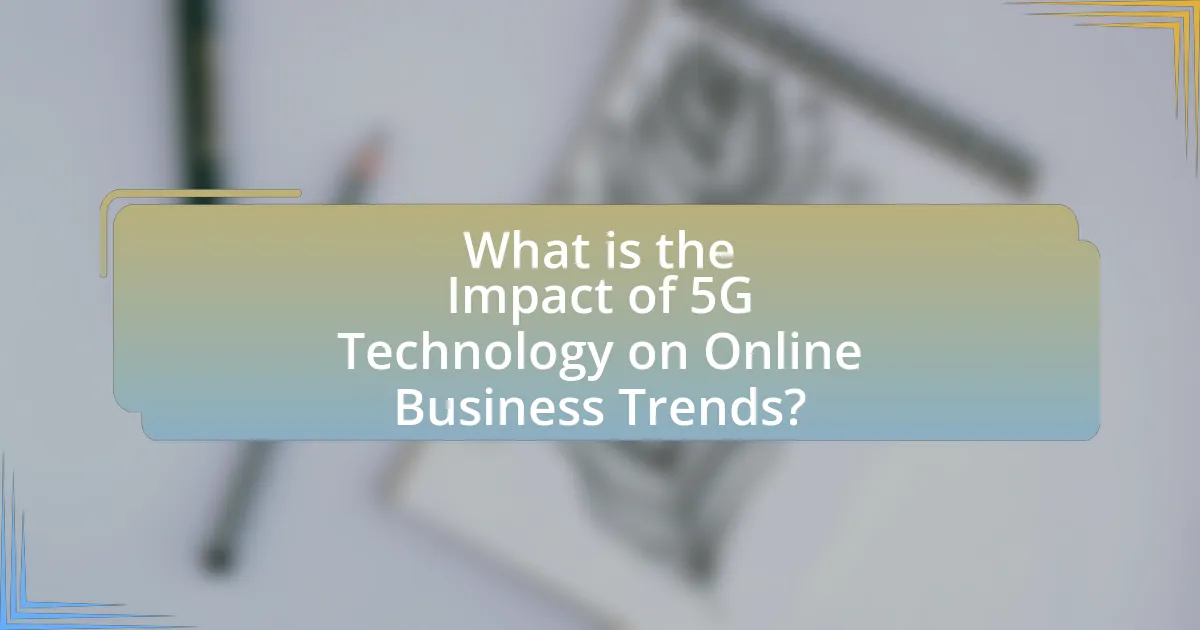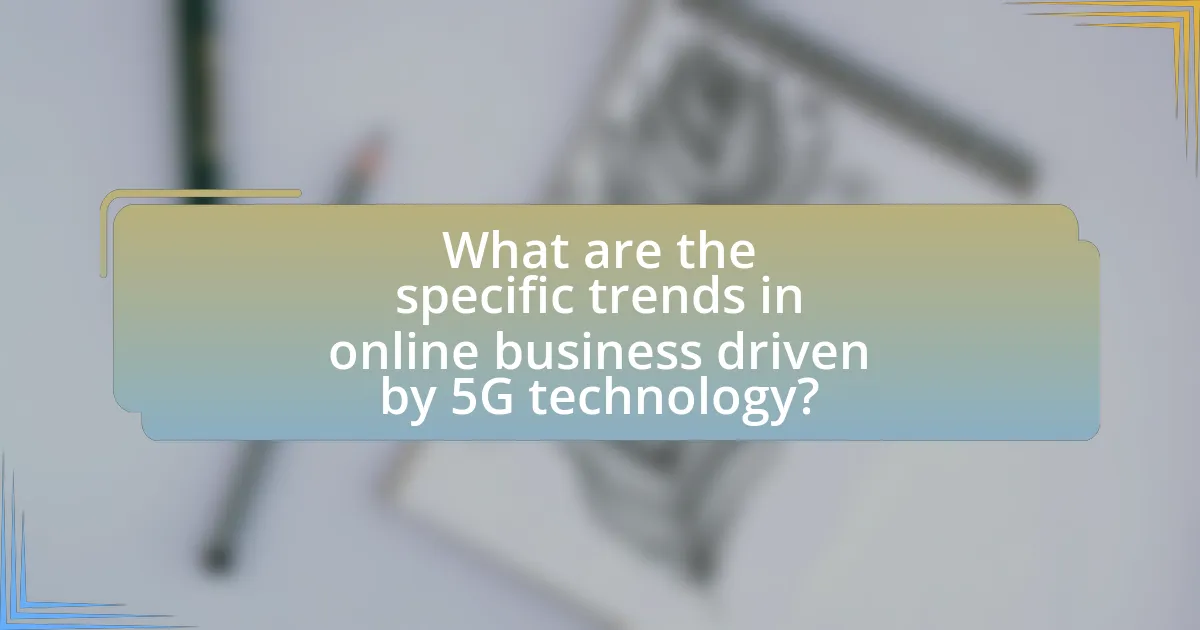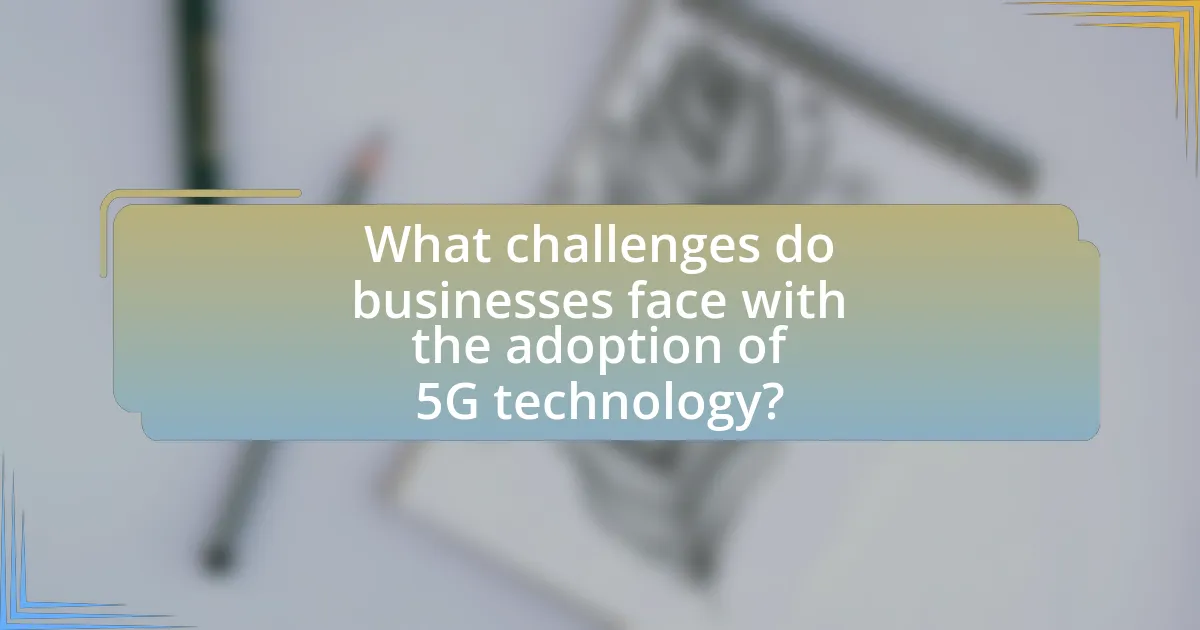5G technology is revolutionizing online business trends by providing faster data transfer, lower latency, and enhanced connectivity. This advancement enables businesses to utilize real-time data analytics, improve customer experiences, and adopt innovative applications such as augmented reality and IoT. Key features of 5G include significantly higher data speeds, increased capacity for connected devices, and improved reliability, which collectively drive growth in e-commerce and mobile commerce. However, businesses must also navigate challenges such as infrastructure costs, regulatory hurdles, and security concerns to fully leverage the benefits of 5G technology.

What is the Impact of 5G Technology on Online Business Trends?
5G technology significantly enhances online business trends by enabling faster data transfer, lower latency, and improved connectivity. This advancement allows businesses to leverage real-time data analytics, enhance customer experiences through seamless interactions, and adopt innovative technologies such as augmented reality and IoT applications. For instance, a report by Ericsson indicates that 5G can provide up to 100 times faster data speeds compared to 4G, which can lead to increased efficiency and productivity in online transactions. Additionally, businesses can utilize 5G to support remote work and digital collaboration tools more effectively, further driving the shift towards digital-first strategies in the marketplace.
How does 5G technology differ from previous generations?
5G technology differs from previous generations primarily through its significantly higher data speeds, lower latency, and greater capacity for connected devices. While 4G networks typically offer speeds up to 1 Gbps, 5G can reach speeds exceeding 10 Gbps, enabling faster downloads and improved streaming quality. Additionally, 5G reduces latency to as low as 1 millisecond compared to 30-50 milliseconds in 4G, which enhances real-time communication and responsiveness in applications like online gaming and virtual reality. Furthermore, 5G networks can support up to 1 million devices per square kilometer, vastly increasing the number of connected devices compared to 4G’s limit of around 100,000 devices. These advancements facilitate innovations in various sectors, including online business, by enabling more efficient operations and new service offerings.
What are the key features of 5G technology?
The key features of 5G technology include enhanced data speeds, reduced latency, increased capacity, and improved connectivity. Enhanced data speeds can reach up to 10 Gbps, significantly faster than 4G, enabling quicker downloads and smoother streaming. Reduced latency, often as low as 1 millisecond, allows for real-time communication, which is crucial for applications like autonomous vehicles and remote surgeries. Increased capacity supports a higher number of connected devices per square kilometer, facilitating the growth of the Internet of Things (IoT). Improved connectivity ensures more reliable connections in densely populated areas, enhancing user experience and enabling new business models. These features collectively transform online business trends by enabling advanced applications and services that rely on high-speed, low-latency communication.
How does 5G enhance connectivity for online businesses?
5G enhances connectivity for online businesses by providing significantly faster data transfer speeds, lower latency, and increased network capacity. These improvements enable businesses to deliver real-time services, enhance customer experiences, and support a higher number of connected devices simultaneously. For instance, 5G can achieve download speeds up to 10 Gbps, which is up to 100 times faster than 4G, allowing for seamless video streaming and instant data access. Additionally, the reduced latency of around 1 millisecond facilitates quicker response times for applications, which is crucial for online transactions and customer interactions. This technological advancement supports the growing demand for high-quality digital services and applications, ultimately driving business growth and innovation.
Why is 5G technology important for online business growth?
5G technology is crucial for online business growth because it significantly enhances data transmission speeds and reduces latency. This improvement allows businesses to deliver faster services, improve customer experiences, and support advanced applications such as augmented reality and real-time analytics. For instance, 5G can achieve speeds up to 10 Gbps, which is up to 100 times faster than 4G, enabling seamless streaming and instant data access. Additionally, the low latency of 1 millisecond facilitates real-time interactions, essential for e-commerce and customer service. These capabilities empower businesses to innovate, optimize operations, and expand their market reach effectively.
What advantages does 5G provide to e-commerce platforms?
5G provides significant advantages to e-commerce platforms by enabling faster data transfer, lower latency, and improved connectivity. These enhancements allow for seamless user experiences, such as quicker page loads and real-time inventory updates, which can lead to higher conversion rates. For instance, 5G networks can achieve speeds up to 10 Gbps, compared to 4G’s maximum of 1 Gbps, facilitating smoother transactions and richer multimedia content. Additionally, the reduced latency of 1 millisecond in 5G compared to 30-50 milliseconds in 4G enhances interactive features like augmented reality shopping experiences, making them more viable and engaging for consumers. This technological leap supports e-commerce platforms in meeting the growing demand for instant gratification and personalized shopping experiences.
How does 5G technology improve customer experience in online businesses?
5G technology significantly improves customer experience in online businesses by providing faster data speeds, lower latency, and enhanced connectivity. These advancements enable seamless streaming, quicker downloads, and real-time interactions, which are crucial for online shopping and service delivery. For instance, 5G can reduce latency to as low as 1 millisecond, compared to 30-50 milliseconds with 4G, allowing customers to engage with websites and applications without delays. Additionally, the increased bandwidth supports more devices simultaneously, ensuring that high-quality video content and interactive features function smoothly, thereby enhancing user satisfaction and engagement.

What are the specific trends in online business driven by 5G technology?
The specific trends in online business driven by 5G technology include enhanced mobile broadband, increased IoT connectivity, and improved real-time data processing. Enhanced mobile broadband allows businesses to deliver high-quality video streaming and immersive experiences, which is crucial for sectors like e-commerce and entertainment. Increased IoT connectivity enables businesses to leverage smart devices for better inventory management and customer engagement, as evidenced by a report from the GSMA, which predicts that by 2025, there will be over 25 billion connected IoT devices globally. Improved real-time data processing facilitates faster transactions and personalized customer experiences, leading to higher conversion rates. These trends collectively transform how businesses operate and interact with consumers in a digital landscape.
How is 5G influencing mobile commerce?
5G is significantly influencing mobile commerce by enabling faster data transfer speeds and lower latency, which enhances the overall user experience. This technology allows for seamless transactions, real-time inventory updates, and improved customer engagement through augmented reality and virtual reality applications. According to a report by Ericsson, 5G networks can provide speeds up to 100 times faster than 4G, facilitating quicker loading times for mobile shopping apps and websites. This increased efficiency is expected to drive higher conversion rates and boost sales in mobile commerce.
What role does 5G play in the rise of mobile payment solutions?
5G significantly enhances mobile payment solutions by providing faster data transfer speeds, lower latency, and improved connectivity. These advancements enable real-time transactions, which are crucial for seamless payment experiences. For instance, 5G networks can support multiple devices simultaneously without degradation in performance, allowing businesses to handle a higher volume of transactions efficiently. According to a report by the GSMA, 5G is expected to contribute to a 20% increase in mobile payment transactions by 2025, demonstrating its pivotal role in the growth of this sector.
How does 5G enhance mobile app performance for businesses?
5G enhances mobile app performance for businesses by providing significantly faster data transfer speeds, lower latency, and increased connectivity. These improvements enable mobile applications to load content more quickly, facilitate real-time interactions, and support a higher number of simultaneous users without degradation in performance. For instance, 5G networks can achieve speeds up to 10 Gbps, compared to 4G’s maximum of around 1 Gbps, allowing businesses to deliver richer multimedia experiences and more complex functionalities in their apps. Additionally, the reduced latency of 1 millisecond in 5G networks compared to 30-50 milliseconds in 4G networks ensures that user interactions are more responsive, which is crucial for applications requiring instant feedback, such as gaming or video conferencing. This combination of speed and responsiveness directly translates to improved user satisfaction and engagement, ultimately benefiting business performance.
What impact does 5G have on digital marketing strategies?
5G significantly enhances digital marketing strategies by enabling faster data transmission and improved connectivity. This increased speed allows marketers to deliver high-quality content, such as 4K videos and augmented reality experiences, without lag, thereby improving user engagement. According to a report by Ericsson, 5G networks can provide up to 100 times faster data rates than 4G, which can lead to higher conversion rates as consumers are more likely to engage with rich media content. Additionally, the low latency of 5G facilitates real-time interactions, allowing brands to implement more personalized marketing tactics and instant customer feedback mechanisms. This technological advancement ultimately transforms how businesses connect with their audience, making digital marketing more effective and responsive.
How can businesses leverage 5G for targeted advertising?
Businesses can leverage 5G for targeted advertising by utilizing its high-speed connectivity and low latency to deliver personalized content in real-time. This technology enables businesses to analyze consumer behavior and preferences more effectively, allowing for the deployment of ads that are tailored to individual users based on their location and online activity. For instance, a study by Qualcomm indicates that 5G can enhance mobile broadband speeds by up to 100 times compared to 4G, facilitating richer media experiences such as augmented reality ads that engage users more deeply. Additionally, the increased capacity of 5G networks allows businesses to reach a larger audience simultaneously, optimizing ad delivery and improving conversion rates.
What new opportunities does 5G create for content delivery?
5G creates new opportunities for content delivery by enabling faster data transmission, lower latency, and increased bandwidth. These enhancements allow for high-definition video streaming, augmented reality experiences, and real-time interactive content, which were previously limited by slower networks. For instance, 5G can support 4K and 8K video streaming without buffering, enhancing user engagement and satisfaction. Additionally, the technology facilitates the deployment of IoT devices that can deliver personalized content based on real-time data analytics, further optimizing user experiences. According to a report by Ericsson, 5G networks can achieve speeds up to 10 Gbps, significantly improving content delivery capabilities.

What challenges do businesses face with the adoption of 5G technology?
Businesses face several challenges with the adoption of 5G technology, including high infrastructure costs, regulatory hurdles, and security concerns. The deployment of 5G requires significant investment in new infrastructure, such as antennas and fiber optics, which can strain budgets, especially for small and medium-sized enterprises. Additionally, navigating the complex regulatory landscape can delay implementation, as businesses must comply with various local and national regulations. Security is another critical challenge, as the increased connectivity and data transfer associated with 5G can expose businesses to greater cybersecurity risks, necessitating enhanced security measures to protect sensitive information.
What are the potential security concerns associated with 5G?
The potential security concerns associated with 5G include increased vulnerability to cyberattacks, risks of data breaches, and challenges in securing the network infrastructure. The deployment of 5G technology expands the attack surface due to its reliance on a more complex architecture and the integration of numerous connected devices, which can be exploited by malicious actors. For instance, a report by the European Union Agency for Cybersecurity (ENISA) highlights that the use of software-defined networking and network slicing in 5G can introduce new vulnerabilities if not properly secured. Additionally, the reliance on third-party vendors for hardware and software components raises concerns about supply chain security, as evidenced by incidents involving compromised equipment. These factors collectively contribute to a heightened risk profile for businesses leveraging 5G technology.
How can businesses mitigate risks related to data privacy in a 5G environment?
Businesses can mitigate risks related to data privacy in a 5G environment by implementing robust encryption protocols and adopting comprehensive data governance frameworks. Encryption protects sensitive data during transmission, making it difficult for unauthorized parties to access it. For instance, the use of end-to-end encryption can secure communications over 5G networks, which are more susceptible to interception due to their high-speed capabilities. Additionally, establishing data governance frameworks ensures compliance with regulations such as GDPR and CCPA, which mandate strict data handling and privacy practices. According to a report by the International Data Corporation, organizations that prioritize data privacy measures can reduce the likelihood of data breaches by up to 60%.
What measures can be taken to ensure network reliability with 5G?
To ensure network reliability with 5G, implementing robust infrastructure, enhancing network slicing, and utilizing advanced error correction techniques are essential measures. Robust infrastructure involves deploying a dense network of small cells to improve coverage and reduce latency, which is critical for maintaining consistent service quality. Network slicing allows operators to create multiple virtual networks on a single physical infrastructure, enabling tailored services for different applications, thus enhancing reliability for specific business needs. Advanced error correction techniques, such as Turbo codes and LDPC (Low-Density Parity-Check) codes, improve data transmission integrity, reducing packet loss and ensuring a stable connection. These measures collectively contribute to a more reliable 5G network, supporting the increasing demands of online business trends.
How can businesses prepare for the transition to 5G technology?
Businesses can prepare for the transition to 5G technology by investing in infrastructure upgrades, training employees, and developing new applications that leverage 5G capabilities. Upgrading infrastructure includes enhancing network equipment and ensuring compatibility with 5G standards, which can improve data speeds and connectivity. Training employees on 5G technology and its applications is essential for maximizing its potential benefits, as it enables staff to utilize new tools effectively. Additionally, businesses should explore innovative applications, such as IoT integration and enhanced mobile experiences, to capitalize on the increased bandwidth and lower latency that 5G offers. According to a report by the GSMA, 5G is expected to contribute $2.2 trillion to the global economy by 2030, highlighting the importance of early adoption and preparation for businesses.
What infrastructure upgrades are necessary for 5G implementation?
Infrastructure upgrades necessary for 5G implementation include the installation of small cell networks, enhanced fiber optic backhaul, and the deployment of advanced antennas. Small cell networks are crucial as they provide the dense coverage required for high-frequency 5G signals, which have limited range. Enhanced fiber optic backhaul is needed to support the increased data traffic and ensure low latency, as 5G networks require significantly more bandwidth than previous generations. Additionally, advanced antennas, such as Massive MIMO (Multiple Input Multiple Output), are essential for improving signal quality and capacity, allowing multiple users to connect simultaneously without degradation of service. These upgrades are validated by industry reports indicating that successful 5G deployment hinges on these critical infrastructure enhancements.
How can companies train their workforce to adapt to 5G advancements?
Companies can train their workforce to adapt to 5G advancements by implementing targeted educational programs that focus on the technical aspects and applications of 5G technology. These programs should include hands-on workshops, online courses, and collaborative projects that emphasize real-world use cases of 5G, such as enhanced connectivity, IoT integration, and data analytics.
For instance, a study by the International Telecommunication Union highlights that organizations that invest in continuous learning and development see a 24% increase in employee productivity. By providing resources and training that align with 5G capabilities, companies can ensure their workforce is equipped to leverage the technology effectively, ultimately driving innovation and improving operational efficiency.
What best practices should businesses follow to maximize the benefits of 5G technology?
To maximize the benefits of 5G technology, businesses should invest in infrastructure upgrades, adopt IoT solutions, and enhance data analytics capabilities. Upgrading infrastructure ensures compatibility with 5G’s high-speed and low-latency features, which can significantly improve operational efficiency. Implementing IoT solutions allows businesses to leverage real-time data for better decision-making and customer engagement. Enhancing data analytics capabilities enables organizations to analyze vast amounts of data generated by 5G networks, leading to more informed strategies and improved customer experiences. According to a report by Ericsson, 5G is expected to enable a 10-fold increase in data traffic, highlighting the importance of these practices for businesses aiming to stay competitive in a rapidly evolving digital landscape.
How can businesses effectively integrate 5G into their existing operations?
Businesses can effectively integrate 5G into their existing operations by upgrading their infrastructure to support higher bandwidth and lower latency, which enhances connectivity and data transfer speeds. This integration involves investing in 5G-compatible devices and systems, training employees on new technologies, and collaborating with telecom providers to ensure seamless connectivity. For instance, a study by the GSMA indicates that 5G can increase mobile broadband speeds by up to 100 times compared to 4G, enabling businesses to leverage real-time data analytics and improve customer experiences. Additionally, companies can implement IoT solutions that utilize 5G networks to optimize supply chain management and enhance operational efficiency.
What strategies can enhance customer engagement through 5G technology?
Implementing interactive augmented reality (AR) experiences is a strategy that can significantly enhance customer engagement through 5G technology. The high-speed, low-latency capabilities of 5G enable seamless AR applications, allowing customers to visualize products in real-time and interact with them in a more immersive way. For instance, a study by Ericsson found that 5G can support up to 1 million devices per square kilometer, facilitating widespread use of AR applications in retail environments. This level of connectivity allows businesses to create personalized shopping experiences, increasing customer satisfaction and loyalty.





